The Würzburg Residence is one of the largest and most beautiful Baroque palaces in Germany. The Würzburg Residence was built in the period 1720-1744 by the Prince-Bishops Johann Philipp Franz von Schonbörn and Friedrich Carl von Schonbörn. The court architect Balthasar Neumann was ordered to prepare plans for the residence, he supervised the construction of the Würzburg Residence. Balthasar Neumann was one of the most famous German architects of his time, he designed many buildings, among them Augustusburg Castle near Cologne and the New Town Hall of Bamberg. The design of the Würzburg Residence is a sublime combination of western architecture of that time, it was based on the Palace of Versailles, the Baroque architecture of Vienna and the architecture of northen Italy. It took years to decorate the Würzburg Residence. The Old Master Giovanni Battista Tiepolo painted the frescoes on the walls and the ceiling of the Imperial Staircase, the 'Kaisersaal' and the Imperial Hall. The famous Imperial Staircase with its unsupported vaulted ceiling contains the largest ceiling frescoe in the world (18 x 30 metres). The staircase with the famous frescoe of Tiepolo survived the Allied bombing of Würzburg in WWII, the mirror cabinet was completely destroyed, based on a preserved mirror fragment and numerous photos, the mirror cabinet was reconstructed from 1979 to 1987. The Court chapel is one of the most splendid 18th century religious buildings in Germany. The Würzburg Residence is surrounded by gardens, decorated with garden vases and garden statues, mostly of Chinese and Moorish children. The Würzburg Residence Court Gardens are a true masterpiece of garden design. The Würzburg Residence with the Court Gardens and the Residence Square gained the status as a UNESCO World Heritage in 1981.
www.werelderfgoedfotos.nl © Copyright World Heritage Photos
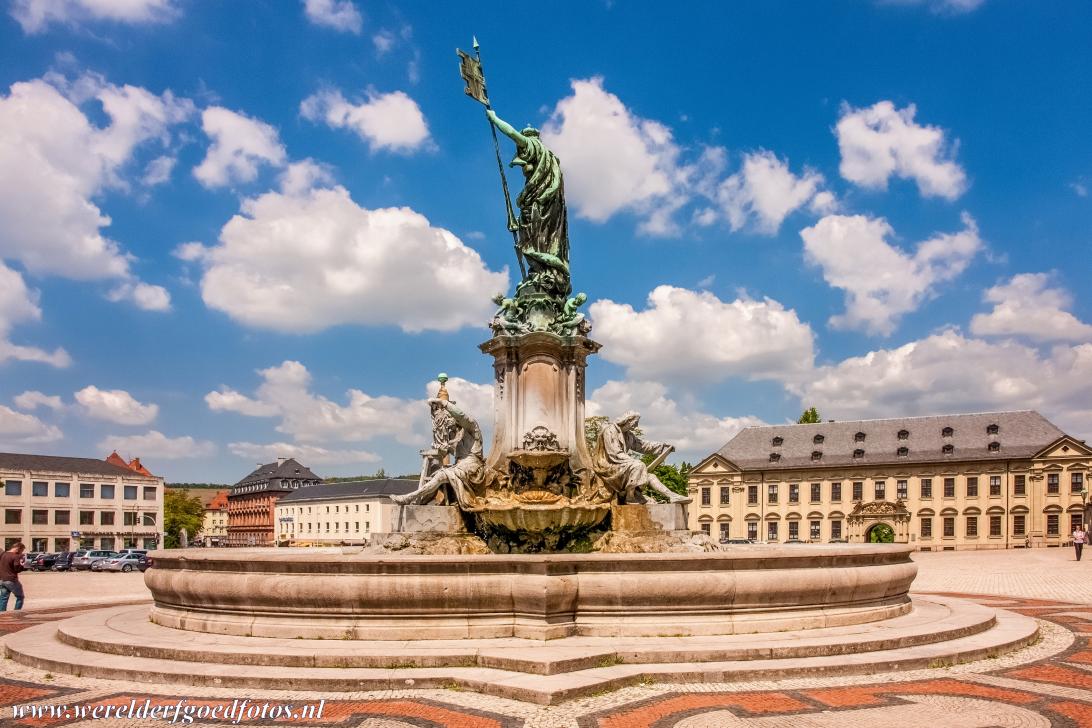
The Frankonia Fountain on the Cour d'Honneur, the Residence Square, in front of the Würzburg Residence. The fountain was created in 1894 in honour of prince regent Luitpold of Bavaria and is adorned with several statues of historic figures. The residence and the town of Würzburg are separated from each other by the enormous Residence Square. The Würzburg Residence with the Court Gardens and the Residence Square was declared a UNESCO World Heritage in 1981.

The Frankonia Fountain on the Cour d'Honneur, the Residence Square, in front of the Würzburg Residence. The fountain was created in 1894 in honour of prince regent Luitpold of Bavaria and is adorned with several statues of historic figures. The residence and the town of Würzburg are separated from each other by the enormous Residence Square. The Würzburg Residence with the Court Gardens and the Residence Square was declared a UNESCO World Heritage in 1981.
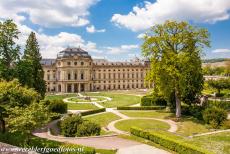
View of the Imperial Hall from the East Garden of the Würzburg Residence. The residence was created under the Prince-Bishops Johann Philipp Franz and Friedrich Carl von Schonbörn. The principal architect of the residence was Balthasar Neumann, he also supervised the building of the residence. The exterior was built in 1720 -1744, but it took almost 40 years to complete the interior of the Würzburg Residence.
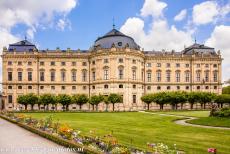
The design of the Würzburg Residence is a sublime combination of western architecture of that time, based on the Baroque architecture of Vienna, the architecture of the Palace of Versailles in France and the architecture of northen Italy. One of the highlights of the Würzburg Residence is the Imperial Staircase. The Venetian artist Giovanni Battista Tiepolo painted the frescoes on the walls and the ceiling of the Imperial Staircase and the Kaisersaal, the Imperial Hall.
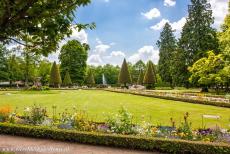
The South Garden of the Würzburg Residence is characterized by a number of imposing yews, the Court Gardens were laid out between 1765 and 1780. Several rare species of flowers and plants grow in the garden. The flower beds are surrounded by low boxwood hedges and Taxus baccata pruned into conical shapes. Colourful flower beds are framing the South Garden. Many parts of the Würzburg Court Gardens have been restored to their original designs.

Würzburg Residence: In front of the impressive east façade is a terraced garden decorated with several putti, small statues of chubby infants. The Court Gardens of the Würzburg Residence are adorned with fountains, statues of putti, garden vases and two sculpture groups. The Würzburg Residence with the Court Gardens and the Residence Square was added to the UNESCO World Heritage List in 1981.
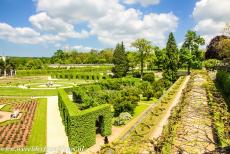
Würzburg Residence: View across the East Garden from the terraced garden. The total area of the Court Gardens is little more than three times that of the Würzburg Residence. The gardens were designed in the Baroque style. The Court Gardens are made up of three smaller gardens, the East Garden, the South Garden and a kitchen garden. The gardens contain statues, pergola walks, fountains, potted plants, fruit trees and evergreens clipped into formal shapes.
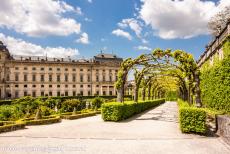
Würzburg Residence and Court Gardens: One of the most noteworthy features of the residence is the Imperial Staircase. A huge fresco covers the entire ceiling above the Imperial Staircase, the amazing fresco was painted by the Venetian artist Giovanni Battista Tiepolo in 1753, it is one of the largest frescoes ever created. Giovanni Tiepolo also decorated the 'Kaisersaal', the Imperial Hall. The 'Wiesser Saal', the White Hall, was the audience chamber, decorated by Antonio Bossi.
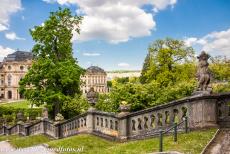
Würzburg Residence: The East Garden, the cupola of the Imperial Hall in the background. During an Allied air raid in March 1945, the residence was severely damaged, the Imperial Staircase and several other rooms were spared. After WWII, the restoration works on the residence started, it took more than forty years and was completed in 1987. The Würzburg Residence with the Court Gardens and Residence Square gained the status as a UNESCO World Heritage in 1981.

Würzburg Residence: A monumental staircase leading up to a terrace in the East Court Garden. The Mirror Cabinet is one of the most notable rooms of the Würzburg Residence, the cabinet is completely covered with mirrors, framed in gold leaf, the Mirror Cabinet was totally devastated by an air raid during WWII. Based on a preserved mirror fragment and numerous pictures, the Mirror Cabinet was reconstructed from 1979 to 1987. The cabinet looks like it once was.
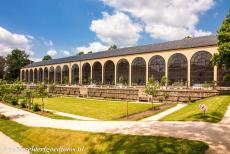
Würzburg Residence: The orangery with the kitchen garden in front of it. In the beginning of the 19th century, the kitchen garden was laid out in the Court Gardens of the residence. The original design remained almost unchanged until the 1960s. The reconstruction of the kitchen garden of the residence took place between 1998 and 2001, the new fruit trees are cultivated according to traditional pruning and training methods.
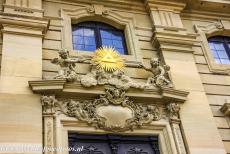
Würzburg Residence: The Eye of Providence above the entrance of the Court Chapel. The small Court Chapel or Hofkirche is lavishly adorned with marble sculptures, frescoes, stucco and gold leaf. The chapel was also designed by Balthasar Neumann and decorated by Giovanni Battista Tiepolo. The Court chapel is one of the most perfect 18th century religious buildings in Germany and is one of the highlights of the Würzburg Residence.
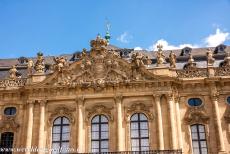
Würzburg Residence: The sculpted Coat of Arms of the Prince-Bishops von Schonbörn above the main entrance. The huge residence is one of the most important Baroque palaces in Europe, the more than 300 chambers were decorated by the most famous artists of that time, the residence is decorated with impressive frescoes, tapestries and extravagant furniture. The rooms are only accessible by guided tour. Photography inside the Würzburg Residence is not allowed.
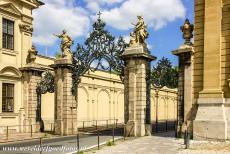
Würzburg Residence: The Court Gardens can be entered through wrought-iron gates, loated on the east side of the Cour d'Honneur, the Residence Square in front of the Würzburg Residence, the impressive square measures 200 metres by 100 metres. The Court Gardens are situated at the edge of the fortified town walls of Würzburg. The gardens were laid out on three terraces, the highest terrace meets the town walls.
